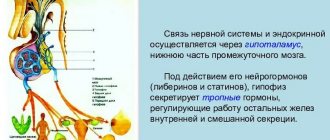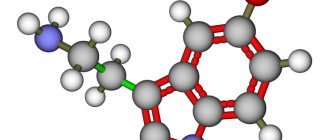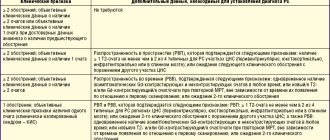The thyroid gland and its hormones
The thyroid gland and its hormones, together with the nervous and immune systems, take part in the coordination and regulation of the work of all human organs (heart, brain, kidneys, etc.).
In a coordinated “orchestra” of signals, nerve impulses and biological substances, thyroid hormones play the role of the “main violin”. The reason for the special importance of thyroid hormones for the body is that they are needed by all tissues and every cell. Simply put, it is impossible to exist without them.
The role of the thyroid gland is so significant that its study is separated into a separate discipline - thyroidology, and after the accident at the Chernobyl nuclear power plant and Fukushima, it is under close attention.
The problem of imbalance of thyroid hormones has been known for many centuries. Ancient Roman doctors were the first to draw attention to the increase in its size during adolescence and pregnancy. Before our era, China already knew how to prevent the appearance of goiter - an enlarged gland - by eating seaweed. In the Renaissance, a rounded and swollen neck was a sign of female attractiveness, which Rembrandt, Durer, and Van Dyck emphasized in their paintings. A nervous and excitable disposition, as a result of an excess of thyroid hormones, was in fashion in the 17th century in Spain. Calm and graceful slowness was valued by the aristocrats of Switzerland, but they did not suspect that the reason for this was a deficiency of iodine, necessary for the thyroid gland.
Structure of the thyroid gland
The thyroid gland is located on the front of the neck, just below the Adam's apple. The ancient Roman physician Galen first described the gland as a separate organ, and it received its name much later in the 17th century. The name of the gland comes from the Greek words “thyreos” - shield and “idos” - view, i.e. an organ that looks like a shield. The international name for this internal secretion organ is the thyroid gland. The shape of the thyroid gland resembles a butterfly or a horseshoe; it has three main parts - two lateral lobes and an isthmus. Every third person has another non-permanent lobule - pyramidal.
The size of the gland can vary significantly even in the same person, depending on the activity of its functioning. Gender, age, climate, medication use and, of course, diet largely influence the size and amount of gland hormones. Due to the tight connection with the larynx, its position can change, it rises and falls when swallowing, moves to the side when turning the head in different directions, which is visible to the naked eye
The structure of the thyroid gland is quite complex. Under a microscope, it is noticeable that it consists of many vesicles - follicles. Along the edges of the follicles there are cells - thyrocytes, and inside the follicle there is a thick watery liquid - colloid. Thyrocytes synthesize hormones, and they accumulate in a colloid for immediate release into the blood when needed.
In the walls of the follicles between the cells, as well as between the follicles themselves, there are larger, lighter parafollicular cells (C-cells), which produce the hormone calcitonin, which is involved in the regulation of calcium and phosphorus metabolism. It inhibits the removal of calcium from bones and reduces calcium levels in the blood.
Thyroid hormones
The main two hormones produced by the thyroid gland are triiodothyronine (contains three iodine molecules) and tetraiodothyronine or thyroxine (contains four iodine molecules). Thyroid hormones are abbreviated as T3 and T4. In the cells and tissues of the body, T4 gradually turns into T3, which is the main biologically active hormone that directly affects metabolism.
The formation of thyroid hormones is associated with a specific protein, thyroglobulin. Thyroglobulin serves as a reserve form of thyroid hormones and is located inside the colloid.
In the preparation of thyroid hormones, two essential components are required - iodine and the essential amino acid tyrosine. To form one T4 molecule, four iodine molecules are needed, while T3 requires only three. Without iodine, hormone synthesis stops completely. This is why it is so important to prevent iodine deficiency in food. Tyrosine enters the body with food; it is a precursor in the formation of not only thyroid hormones, but also adrenaline, melanin, and dopamine.
There are four stages in the process of synthesis of thyroid hormones:
1. Absorption of iodine by the thyroid gland. Its concentration in the gland is 30-40 times higher than in the blood.
2. Activation of iodine, which makes it possible for it to bind to the amino acid tyrosine molecule.
3. Condensation with the formation of hormones - thyroxine and triiodothyronine and their accumulation in the composition of thyroglobulin in the form of a colloid.
4. Release of formed hormones into the blood under the influence of TSH.
Thyroid hormones are very small in size and must be bound to transport proteins before entering the blood so as not to be “washed out” of the body by the kidneys. The level of free hormones is 0.03% of the total; they provide all the effects of thyroid hormones. In tissues, thyroxine (T4) is converted into triiodothyronine (T3) and the biological effect of hormones is 90% due to T3.
Thyroid gland: its functions and diseases
The thyroid gland plays a vital role in the functioning of our body; if it functions incorrectly, metabolic processes are disrupted and other systems malfunction. It is no coincidence that one day of the year is dedicated to this organ - today, May 25, is World Thyroid Day.
Alla Petrovna Makarovskaya, an endocrinologist at the National Medical Research Center for Therapy and Preventive Medicine of the Russian Ministry of Health, spoke about how the thyroid gland works, what hormones it produces and what function it performs.
“The thyroid gland is one of the largest endocrine glands, located under the larynx, anterior to the trachea, consists of two lobes and an isthmus (butterfly-shaped).
The name “thyroid” was assigned to it by the anatomist Thomas Worth in 1656; the gland’s shape reminded him of the shields of the warriors of Ancient Greece. And the first mentions of the thyroid gland date back to the 4th century BC. - they were discovered in the writings of Hippocrates and Plato, in the works of physicians of Ancient Greece, India and Egypt. According to WHO statistics, among endocrine disorders, thyroid diseases are in second place after diabetes mellitus.
This “butterfly” gland has its own holiday: May 25 – World Thyroid Day. The date was proposed in 2008 by the European Thyroid Association.
The thyroid gland produces hormones: thyroxine (T4) and triiodothyronine (T3), which, released directly into the blood, affect all cells and tissues of the body, regulate the speed of various metabolic processes, thereby influencing the functions of all organs and systems.
In the blood, most of the thyroid hormones are bound to proteins, they are biologically inactive, and only a small protein-free fraction of hormones actively performs its functions (free T3 and free T4). The “conductor” of the work of the entire endocrine system is the hypothalamic-pituitary system, which consists of two glands: the pituitary gland, located at the base of the brain, and the hypothalamus, located in the brain slightly above the pituitary gland.
The thyroid gland, pituitary gland, and hypothalamus work in concert to control thyroid hormone levels. If, for example, there is not enough thyroid hormone in the blood, the pituitary gland increases the production of its thyroid-stimulating hormone (or TSH), which stimulates an increase in the production of hormones by the gland. Once normal thyroid hormone levels are restored, TSH production slows down and approaches normal levels.
The state of normal functioning of the thyroid gland is called euthyroidism (“eu-” translated from Greek means “good”, “normal”). If the thyroid gland does not produce enough hormones, then metabolic processes in the body slow down. This condition is called hypothyroidism.
If there are more thyroid hormones than necessary, the metabolism increases and the opposite state of hypothyroidism develops - hyperthyroidism.
Symptoms of hypo- and hyperthyroidism are not specific only to thyroid dysfunction; they can be associated with completely different problems. In order to accurately assess the activity of the thyroid gland, it is enough to donate blood, which primarily evaluates the level of TSH, free T4 and free T3.
The term “goiter” refers to an enlarged thyroid gland. Currently, an accurate method for determining its size and structure is ultrasound examination. Autoimmune diseases of the thyroid gland have become widespread. Diseases of this type are diffuse toxic goiter (DTG) and autoimmune thyroiditis (AIT). Each of them occurs in about one in 100 people.
Other diseases of the thyroid gland are nodules, cancer, subacute thyroiditis. For the differential diagnosis of nodular goiter (thyroid nodules exceeding 1 cm in diameter), fine-needle aspiration biopsy (FNA) is indicated.”
You can make an appointment with an endocrinologist at the Consultative and Diagnostic Center of the National Medical Research Center for Therapy and Preventive Medicine of the Russian Ministry of Health by calling 8 (495) 790-71-72.
Hypothalamus - pituitary gland - thyroid gland
The release of thyroid hormones is controlled by two “superior” endocrine glands. The area of the brain that connects the nervous and endocrine systems is called the hypothalamus. The hypothalamus receives information about the level of thyroid hormones and secretes substances that affect the pituitary gland. The pituitary gland is also located in the brain in the area of a special depression - the sella turcica. It secretes several dozen hormones that are complex in structure and action, but only one of them acts on the thyroid gland - thyroid-stimulating hormone or TSH.
The level of thyroid hormones in the blood and signals from the hypothalamus stimulate or inhibit the release of TSH. For example, if the amount of thyroxine in the blood is small, then both the pituitary gland and hypothalamus will know about it. The pituitary gland will immediately release TSH, which activates the release of hormones from the thyroid gland.
Low temperature and stress lead to more active release of TSH and, accordingly, an increase in the amount of T3 and T4 in the blood. During sleep, TSH is practically not formed.
The triple axis of interaction between the hypothalamic-pituitary-thyroid system allows not only the higher glands to know about the amount of thyroid hormones, but also the nervous system, which directly depends on and influences hormonal regulation.
Endocrine system. Norm and pathology
The endocrine system as a natural phenomenon
The endocrine system, also known as the system of neurohumoral regulation (literally “neuro-fluid control”), is extremely complex.
Its structure, composition and functioning are, apparently, at the limit of what modern science, armed with a powerful (as it seems to it) instrumental, laboratory-analytical and computational arsenal, can in principle explore and comprehend. An entire branch of medicine, called endocrinology, studies this system, its normal operation, its various dysfunctions and diseases, as well as methods for treating the latter. An entire sector of pharmacology is engaged in the development, synthesis and improvement of the so-called. hormone-containing drugs; Despite the chronic problem of side effects, it is no longer possible to do without this group of drugs today. Organs (glands), tissues or cells of a certain type related to the endocrine system, for example, Kulchitsky cells in the intestinal mucosa, produce special organic compounds, which are usually called bioactive regulators, neurotransmitters, signaling biochemicals, but most often simply hormones. This word translated from Greek means “to excite”, “to induce” or, in more modern parlance, “to activate”. Hormones enter directly into the bloodstream; the slightest fluctuations in their concentration in living tissues are captured by specific receptor cells that are sensitive to a particular group of hormones and capable of responding to hormonal “commands” - for example, an increase in body temperature, a decrease in blood pressure in the vessels, intense lactogenesis in the mammary glands, and many others etc. In this way, almost all physiological and mental processes in the body are launched, forced, inhibited or completely suppressed - in a word, controlled. Moreover, each gland secretes, as a rule, several hormones, and each hormone in turn affects several interrelated processes.
It is no coincidence that the synonymous term “neurohumoral regulation” contains the root “neuro-”. According to modern ideas, the endocrine system plays a very important, exclusive role in the life of the body, but still is not the “supreme power” in relation to it. Hierarchical dominance belongs to the central nervous system (CNS), i.e. brain and spinal cord. Hormones are responsible for everything, but the secretory activity of the endocrine glands themselves is controlled by special cerebral formations and appendages, primarily the hypothalamic-pituitary ligament in the lower region of the brain, the so-called. diencephalon - using signal electrochemical impulses and a whole web of neural communication channels (in IT, such an internal network would be called an intranet). Given the above, endocrinology today is increasingly identified with neuroendocrinology (which half a century ago was considered a separate field), and a group of disorders previously traditionally called hormonal are interpreted as neuroendocrine diseases or dysfunctions.
It is difficult to say why such a complex, multi-stage and multi-element neuroendocrine system arose in evolving mammals. As you know, nature cares most about expediency, and least of all about making it convenient for humans to study it. Nature always has a lot of possible paths and options; most likely infinitely many. It would certainly be possible to regulate the life activity of higher organisms in some other way, and preferably in a simpler way. However, the following cannot be denied. Modern, intelligent and technological man is still very far from creating an artificial system similar to himself - a system that is equally compact, energy-saving and efficient, possessing five autonomous sensor units and two universal manipulators; a system that optimally combines strength, flexibility and mobility, unconditioned and conditioned reflexes, consciousness and the unconscious; in addition, a self-reproducing system, to some extent self-learning and, most importantly, maintaining homeostasis (constancy of internal conditions), i.e. self-adjusting to almost any external conditions. Therefore, today we can only admire, thank nature for our amazing endocrine system - and continue the persistent study of its countless mysteries.
Action of thyroid hormones
Unlike most hormones, which act only on certain target cells (for example, for estradiol these are the genitals), thyroid hormones are necessary for normal functioning of all tissues without exception. Penetrating into the cell, the hormone is sent to the nucleus, where it binds to certain areas on the chromosomes and stimulates a complex of reactions, which leads to the activation of oxidation and reduction processes.
The effect of thyroid hormones on the body:
- increased heat release
- activation of protein synthesis necessary for the construction of new cells
- proper growth and development of the central nervous system, especially the brain (especially important for children)
- strengthening the processes of reabsorption in the intestine, the formation of glucose from proteins and fats, increasing the level of glucose in the blood
- stimulation of fat breakdown in fat depots, which leads to weight loss
- anabolic effect – body growth, maturation, bone differentiation
- red blood cell formation
- normal development of the genital organs and the release of sex hormones.
Thymus. thalamus, hypothalamus, pineal gland and pituitary gland
The pituitary gland is the lower cerebral appendage, the pituitary gland is a cerebral appendage in the form of a round formation located on the lower surface of the brain in a bony pocket called the sella turcica, produces hormones that affect growth, metabolism and reproductive function. It is the central organ of the endocrine system; is closely connected and interacts with the hypothalamus.
Pineal gland
,
pineal gland , or pineal gland is a part of the diencephalon, which is part of the nervous and endocrine system, often called the endocrine gland, the main source of melatonin in the body.
It is believed that insomnia, depression, hypertension, obesity, type 2 diabetes mellitus and other serious pathologies may be the result of malfunctioning of the pineal gland. Known general functions of the pineal gland include:
- inhibition of the release of growth hormones;
- inhibition of sexual development and sexual behavior;
- inhibition of tumor development;
- influence on sexual development and sexual behavior. In children, the pineal gland is larger than in adults; Upon reaching puberty, melatonin production decreases.
The cells of the pineal gland are connected to the receptive part of the organ of vision. The pineal gland responds to environmental light. The onset of darkness causes its work to intensify.
In the evening and at night, the blood supply to the pineal gland increases sharply. During this period, hormonally active gland cells secrete and release a large amount of biologically active substances. Peak hormone production occurs between midnight and early morning.
Functions of pineal gland hormones:
- inhibition of the activity of the pituitary gland and hypothalamus at night;
- harmonization of the daily rhythm of sleep and wakefulness;
- decreased nervous excitement;
- hypnotic effect;
- normalization of vascular tone;
- physiological suppression of the reproductive system in childhood.
Functional impairments are relatively easily overcome by following a daily routine and treating concomitant diseases. An important condition for normalizing the production of melatonin and other pineal hormones is sufficient night sleep and a balanced diet.
The thalamus is a region of the brain responsible for the redistribution of information from the senses, with the exception of smell, to the cerebral cortex. This information (impulses) enters the nuclei of the thalamus. In the thalamus, four main nuclei can be distinguished: a group of neurons that redistributes visual information; the nucleus, which redistributes auditory information; a core that redistributes tactile information and a core that redistributes the sense of equilibrium and balance.
After information about any sensation has entered the thalamic nucleus, its primary processing occurs there, that is, temperature, visual image, etc. are first realized.
The thalamus is believed to play an important role in memory processes.
The hypothalamus is a small region in the diencephalon that regulates the neuroendocrine activity of the brain and homeostasis (self-regulation) of the body.
The hypothalamus is connected by nerve pathways to almost all parts of the central nervous system, including the cortex, hippocampus, amygdala, cerebellum, brain stem and spinal cord. Together with the pituitary gland, the hypothalamus forms the hypothalamic-pituitary system, in which the hypothalamus controls the release of pituitary hormones and is the central link between the nervous and endocrine systems. It secretes hormones and neuropeptides and regulates functions such as hunger and thirst, body thermoregulation, sexual behavior, sleep and wakefulness (circadian rhythms). Recent studies show that the hypothalamus also plays an important role in the regulation of higher functions, such as memory and emotional state, and thereby participates in the formation of various aspects of behavior.
How many hormones should there be?
There must be enough hormones to ensure normal functioning of the body. Tests can accurately determine the level of thyroid hormones. The “gold standard” among laboratory methods for analyzing thyroid hormones is radioimmunoassay. But due to the difficulties of using radioactive isotopes, most laboratories conduct tests using the ELISA (enzyme-linked immunosorbent assay) method.
The amount of thyroid hormones depends on:
— the intensity of signals coming from the brain and regulating the functioning and level of thyroid hormones
- the number of working cells in the gland itself
- the presence of a sufficient amount of iodine, which is necessary for the synthesis of hormones.
Normal thyroid hormone levels:
— total triiodothyronine T3 — 1.2-2.8 mIU/l
— total thyroxine T4 — 60.0-160.0 nmol/l
— free triiodothyronine FT3 — 2.5 — 5.8 pmol/l
— free thyroxine FT4 — 11.5-23.0 pmol/l
— thyroid-stimulating hormone TSH, TSH — 0.17-4.05 mIU/l
— thyroglobulin Tg — less than 50 ng/ml
When performing tests for thyroid hormones, not only their quantity is assessed, but also antibody levels. When there are disturbances in the immune response system, antibodies begin to form not only against foreign organisms, but also against “native” tissues. Some of these antibodies disrupt the functioning of the thyroid gland and the action of its hormones. The most common are TSH receptor Ab, anti-thyroglobulin antibody (ATG) and anti-thyroid peroxidase antibody (anti-ATPO).
Antibodies to TSH receptors are similar in structure to TSH and their attachment to receptors on the thyroid gland leads to the active release of T3 and T4. Antibodies to thyroglobulin appear in autoimmune Hashimoto's thyroiditis and pregnancy. Monitoring their levels in the blood indicates the activity of inflammation. Anti-ATPO - antibodies to thyroperoxidase (AMC, antibodies to the microsomal fraction) lead to the destruction of the gland and the release of hormones into the blood.
A condition in which there is enough thyroid hormone for the body is called euthyroidism.
What is a pituitary adenoma?
Pituitary adenoma is a benign round tumor in the brain. It is localized in the area of the sella turcica, near the base of the skull bones. WHO statistics state that adenoma accounts for 80% of all pituitary tumors. It occurs in 1 in 50,000 people, but due to the lack of comprehensive diagnostics, the actual numbers may be much higher.
A pituitary adenoma is a microformation that for a long time may not report itself with any obvious symptoms. It progresses slowly and can only be detected in the initial stages through a detailed diagnostic examination. Adenoma can occur at any age, but most often it affects people 30-60 years old. Rarely occurs in children.
Due to the long-term absence of any symptoms, pituitary adenoma can cause serious endocrine problems: hyperprolactinemia, obesity, Cushing's syndrome. Because of this benign tumor, the synthesis of hormones in the pituitary gland is suppressed, which disrupts the entire endocrine system. Also, the formation, which increases in size, compresses the adjacent brain tissue, causing migraines, epileptic seizures, decreased visual acuity and much more.
Not enough thyroid hormones
Reduced function of the thyroid gland - hypothyroidism, occurs when there is a deficiency of iodine or the intake of substances that disrupt the formation of hormones. Rarer causes of hypothyroidism are the use of certain drugs (for example, cordarone), removal of the gland as a result of tumors or deficiency of TSH secretion. Hypothyroidism in childhood leads to growth retardation, disproportionate growth, mental retardation, and cretinism. Hypothyroidism in adults is called myxedema.
Manifestations of thyroid hormone deficiency:
- weight gain that is not reduced by diet and exercise
- general weakness, constant fatigue, fatigue
- constantly depressed mood
- menstrual irregularities, infertility
– low body temperature (35.6-36.3ºС)
- dry, swollen skin, itching, dandruff that does not disappear when using medicated shampoos, changes in nails
- constant constipation
- constant swelling of the legs, feet, puffiness of the face
- low blood pressure, low heart rate
- inability to warm up even in a warm room
- pain in muscles and joints
- deterioration of memory and reaction speed
One of the forms of hypothyroidism is endemic goiter, which develops when there is insufficient iodine intake in the body. This situation is typical for areas where its level in water and soil is low. Switzerland was one of the first countries to introduce mandatory iodization of salt, sunflower oil and bread back in 1922. There are no cases of hypothyroidism in Switzerland today. Areas of iodine deficiency in Russia are the North Caucasus, the Urals, Altai, the Siberian Plateau, the Far East, the Upper and Middle Volga region, in the North and Central regions of the European part of the country. In Ukraine, these are Volyn, Transcarpathian, Ivano-Frankivsk, Lviv, Rivne, Ternopil regions.
During accidents at nuclear power plants, large amounts of radioactive iodine are released into the air. Radioactive iodine can irradiate the gland from the inside and integrate into thyroid hormones, which leads to active tumor growth. Carrying out iodine prophylaxis helps prevent the entry of radiation iodine into the thyroid gland by replacing it with a stable isotope.
Excess thyroid hormones
With hyperthyroidism - increased work of the thyroid gland, increased synthesis and secretion of T3 and T4, an increase in the size of the gland, exophthalmos (bulging eyes).
Symptoms of elevated thyroid hormone levels:
- - weight loss with increased appetite
- - general weakness, fatigue
- - permanent excitement
- - menstrual irregularities, infertility
- - increased body temperature, sometimes at certain hours (36.9-37.5ºС)
- - dry and sagging skin
- - increased heart rate and high blood pressure
- - feelings of heat
- - deterioration of memory and reaction speed
Hyperthyroidism is observed in the following diseases of the thyroid gland: Bazedow-Graves disease (diffuse toxic goiter), Plummer disease (nodular toxic goiter), de Quervain's viral thyroiditis, autoimmune Hashimoto's thyroiditis. More rare causes of an increase in the amount of thyroid hormones are excessive consumption of thyroid hormones for treatment (thyroxine, euthyrox) or for the purpose of losing weight, for tumors of the ovaries and pituitary gland, and an overdose of iodine preparations.
Symptoms of pituitary adenoma
Most often, pituitary adenoma can be diagnosed based on ophthalmic and neurological signs that arise due to increasing pressure on intracranial structures. It can also be hormone-producing - in this case, endocrine-metabolic syndrome develops.
Ophthalmo-neurological syndrome
The degree of manifestation of ophthalmo-neurological syndrome in pituitary adenoma depends on the volume of the tumor and the direction of its growth. Gradually, a person develops a headache, visual fields decrease, and eye motor activity is disrupted. Migraine occurs due to constant pressure on the sella turcica. It is dull, not accompanied by nausea, and its intensity does not depend on the position of the body.
Headache with pituitary adenoma usually spreads to the temples and frontal region. It is practically not controlled by painkillers. Due to intensive growth, hemorrhage may occur in the tissue, which will lead to a significant increase in headaches.
Limitation of visual fields occurs due to compression of the optic nerves that pass directly under the pituitary gland. Long-term such exposure can lead to atrophy of these nerves and blindness.
As a result of such exposure, ophthalmoplegia and diplopia develop, and visual acuity is significantly reduced. If the adenoma grows downward and affects the ethmoid or sphenoid sinus, the patient may complain of nasal congestion. As the tumor grows predominantly upward, the structures of the hypothalamus are damaged, which can cause disturbances in consciousness.
Endocrine metabolic syndrome
Pituitary adenomas can be hormone-producing. In this case, a person experiences endocrine disorders. Their manifestations depend on the hormone, which becomes abundant in the body. Due to pituitary adenoma, the level of:
- Somatotropin
. This is a growth hormone that causes signs of gigantism in children and acromegaly in adults. The skeleton gradually changes, diabetes mellitus, obesity, diffuse or nodular goiter develop. Manifestations of hirsutism and hyperhidrosis often occur, and nevi and papillomas grow on the skin. - Prolactin
. Women experience menstrual irregularities, infertility, increased body weight, problems with acne, and seborrhea. In men with elevated prolactin, ophthalmo-neurological symptoms and impotence develop. - ACTH
. With elevated corticotropin levels, patients are diagnosed with Cushing's syndrome. The disease can be recognized by bright red stretch marks on the body and skin pigmentation. An adenoma that produces ACTH is dangerous - it has a tendency to malignant degeneration with subsequent metastasis. - TSH
. If the adenoma produces thyrotropin, hyperthyroidism develops. The patient complains of rapid heartbeat, decreased body weight, and excessive sweating. - Gonadotropic hormones
. Mostly nonspecific symptoms occur, such as headache, galactorrhea.
What to do?
In order to determine the quality of the thyroid gland, you need to take tests for hormones and antibodies, as well as do an ultrasound examination. The most important hormones in the thyroid gland are the assessment of free T4 and TSH levels. An ultrasound will show the structure of the gland, its size and volume, and will identify nodes and cysts.
To prevent thyroid diseases, it is worth ensuring that you get enough iodine and tyrosine from your diet. Iodine is found in iodized salt and sunflower oil, kelp seaweed, fish (herring, flounder, cod, halibut, tuna, salmon), crabs, shrimp, squid and other seafood, feijoa. Sources of tyrosine are milk, peas, eggs, peanuts, beans. A nutritious and balanced diet ensures the balance of thyroid hormones and prevents thyroid disease.
Be healthy!










